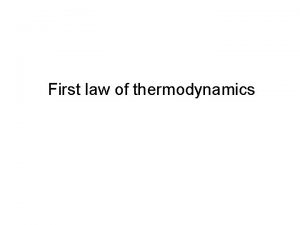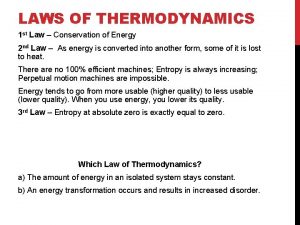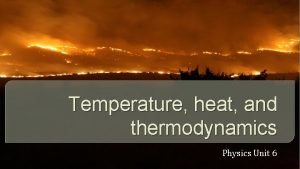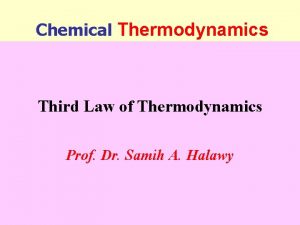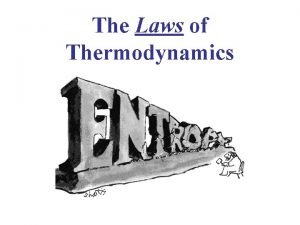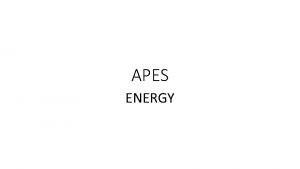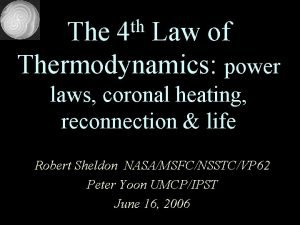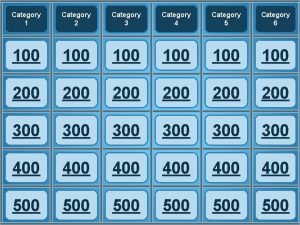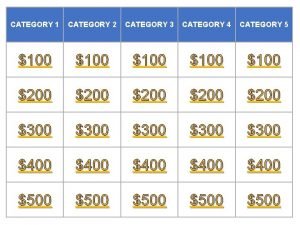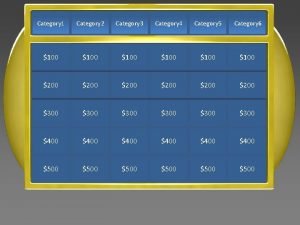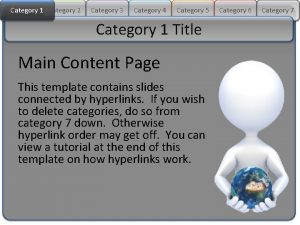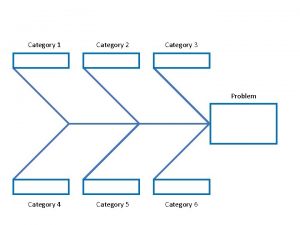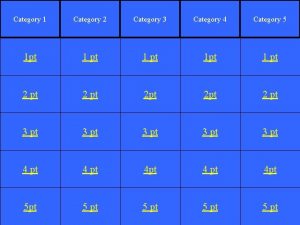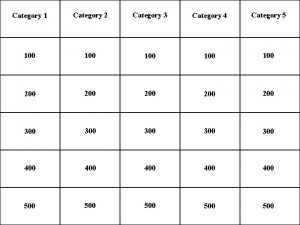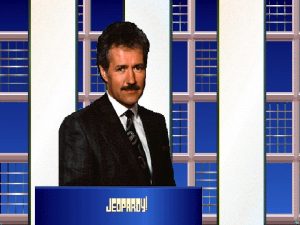1 Category Thermodynamics III The Laws of Thermodynamics





























- Slides: 29

1 Category: Thermodynamics III. The Laws of Thermodynamics Updated: 2014 jan 13

2 Outline A. B. C. D. First Law of Thermo Second Law of Thermo (Entropy) Statistical Mechanics References

A. First Law of Thermo Stored Heat WORK OUT HEAT IN Heat into a system is either stored as internal energy, or performs work on the universe 3

4 1. Work W=F x (a) Recall Definition (b) For a gas expanding against a piston the work done is: W=F x=(PA) x=P(A x) Work done by gas on environment is pressure time change in volume: W=+P V (c) The above formula is only really valid for isobaric process ( P=0 ). Generally it’s the area under the curve of a PV diagram. (example to right is “isothermal process” T=0 )

1. Work continued (a) Isobaric Process: P=0 • W is the work done BY the system • Exact Form: W=+P V (b) Isothermal Process ( T=0 ): 5

2. Internal Energy • Adding heat “Q” to a gas (at constant volume “isovolumetric”) increases its internal energy “U” • For monatomic gas (noble gasses, He, Ne) all the internal energy is in the kinetic energy of molecules • For diatomic gas (e. g. O 2 or H 2), there is more energy stored in rotation and vibration of molecule Note: N=number of molecules, n=number of moles, k=Boltzmann’s constant, R=gas constant, T in Kelvin, Q & U in Joules 6

2 b Specific Heat and gamma (a) Constant Volume Molar Specific Heat Cv • Monatomic Ideal Gas • More generally: • for monatomic for diatomic (b) Constant Pressure Molar Specific Heat Cp=Cv+R = Cv =Cp/Cv, 5/3 for monatomic (7/5 diatomic) 7

2. c Adiabatic Process • Definition: Q=0 (no heat in) • A gas that expands adiabatically will cool (by the first law): Q=0= U+ W 8

9 3. First Law of Thermodynamics (a) The First Law • • • Q= U+ W Q is heat INTO system U is change of internal energy of system W is the work done by system on environment So its based on the law of CONSERVATION of ENERGY BEWARE: Some authors define work as done ON the system by environment and heat flowing OUT of system, so equation will have minus signs.

10 3. b Enthalpy • Definition: H=U+PV • Change in Enthalpy: • • • H= U+P V+ V P Now insert the 2 nd law to get H= Q+ V P • Hence Enthalpy will be conserved in a process which is both isobaric ( P=0) and adiabatic ( Q=0) • Or, for chemistry in an open beaker: H= Q

3. c Gibbs’ Free Energy • Definition: G=U+PV-TS = H-TS • Change in Gibbs: G=V P - S T • Hence Gibbs’ Energy will be conserved in a process which is both isobaric ( P=0) and isothermal ( T=0) [i. e. Chemistry in an open beaker in an ice bath] • Spontaneous reactions occur when: G < 0 11

B. Second Law of Thermo Why does heat flow from hot to cold (instead of the other way around? ) 1. Definition of Entropy: 2. TS Diagrams 3. Entropy of Ideal Gas S= Q/T 12

1. Entropy (a) Definition • Rudolf Clausius (1865) • Extrinsic Quantity: • Units: Joule/Kelvin For example, it takes 334 Joules to melt 1 gram of ice. The entropy of the liquid water is bigger than that of ice: 13

1. b Entropy and First Law (details) From Definition: Q=T S • – • Isentropic Process ( S=0) is equivalent to saying process is adiabatic (if reversible) First Law Restated in terms of Entropy: T S = U + P V 14

1. c Entropy and Gas Volume T S = U + P V • First Law: • For ideal gas, isothermal process ( T=0, or U=0) reduces to: T S=P V • From this we can deduce change in entropy in an isothermal gas expansion is equal to isothermal work done by gas 15

1. d Entropy of Ideal Gas • First Law of Thermo: U=T S-P V • For monatomic ideal gas: U=(3/2)n. R T • For ideal gas: P=(n. RT)/V • Substitute into first law and solve for entropy: • Integrate to get entropy of monatomic ideal gas 16

2. Reversibility (a) Second Law of Thermodynamics • Change in (total) entropy of a closed system tends to increase in time: S 0 • Explains why heat flows from hot to cold, but not the other way around • Example: Heat Q removed from hot water and given to cold water (TH>TC) 17

2 b. Clausius Inequality • Any process obeys the inequality: • For a system to be reversible, all the processes must obey the equality • Example: Free expansion of gas in vacuum. No heat was added ( Q=0), but the entropy has increased due to increased volume: 18

2 c. Irreversibility • Total entropy of universe increases (this tells us the direction of time!) • A open system may decrease in entropy (e. g. freeze water), but the heat exhausted from it increases the entropy of the environment such that the total entropy increases 19

3. Efficiency (a) Carnot Energy Diagram • Sadi Carnot (1824) • QH=Heat from fuel • W=useful work by engine • QC=waste heat exhausted • Conserve Energy • Efficiency 20

3 b. Engines MUST waste heat • From second Law, Entropy must increase • Must waste heat to environment. The colder the environment the less heat must be wasted. • This puts a limit on efficiency (Carnot 1824) 21

3 c. Carnot Cycle (1824) The Carnot Cycle is the best efficient engine that can be made (reversible processes) 22

C. Statistical Mechanics 1. The 3 rd Law of Thermodynamics 2. Probability and Equilibrium 3. Boltzmann’s Definition of Entropy 23

1. The 3 rd law of thermodynamics Aka “Nernst’s Theorem” (1906) a) Impossible to reach absolute zero b) As T 0 the heat capacity approaches zero c) As T 0 all thermodynamic processes stop d) At absolute zero the entropy of a system would be minimum (S=0) 24

25 2. Probability and Equilibrium (a) Equilibrium is the most probable situation (b) Consider 4 particles in a box. – – – Each has a 50/50 chance of being on the Left half (“L”) of the box. There are 24=16 possible microstates The most probable situation is that 2 will be on either side. Macrostate Microstates Frequency Probability 0 LLLL 1 6. 25% 1 LLLR, LLRL, LRLL, RLLL 4 25% 2 LLRR, LRLR, RLLR, RRLL, RLRL, LRRL 6 37. 5% 3 RRRL, RRLR< RLRR, LRRR 4 25% 4 RRRR 1 6. 25%

2 c. Large N systems For example, consider N=40 atoms • Total number of microstates is 2 N= 1, 099, 511, 627, 776 • Only 1 possible for all on same side: Probability 9 x 10 -11% For N=1024 atoms deviations from the average situation are only in the 12 th decimal place! 26

3. Boltzmann Entropy is a measure of the randomness (disorder) of a system Details: S=k Ln( ) • k=Boltzmann’s Constant • =Number of Microstates (for that macrostate), i. e. a measure of disorder. • Maximum order: =1, so S=0 • Maximum disorder is the average “equilibrium” situation of half on each side of box 27

28 References • • http: //www. chem 1. com/acad/webtext/thermeq/TE 3. html http: //stp. clarku. edu/simulations/ http: //intro. chem. okstate. edu/1314 F 00/Laboratory/GLP. htm Good One http: //webphysics. davidson. edu/physlet_resources/bu_semester 1/c 27_process_expansion_sim. html

29 Notes • • Discuss Helmholtz contraction of a star What about Refrigerators? Example: change in entropy by melting ice Demos: Stirling Engine
 Erate pa
Erate pa Hamlet act iii scene ii
Hamlet act iii scene ii Laws in thermodynamics
Laws in thermodynamics 1 law of thermodynamics
1 law of thermodynamics Laws of thermodynamics simple
Laws of thermodynamics simple Laws thermodynamics
Laws thermodynamics Laws of thermodynamics
Laws of thermodynamics Zeroth law of thermodynamics examples
Zeroth law of thermodynamics examples Pros about coal
Pros about coal Thermodynamics laws
Thermodynamics laws Useless laws weaken the necessary laws
Useless laws weaken the necessary laws Ng-html
Ng-html V cc
V cc Làm thế nào để 102-1=99
Làm thế nào để 102-1=99 Alleluia hat len nguoi oi
Alleluia hat len nguoi oi Khi nào hổ mẹ dạy hổ con săn mồi
Khi nào hổ mẹ dạy hổ con săn mồi đại từ thay thế
đại từ thay thế Quá trình desamine hóa có thể tạo ra
Quá trình desamine hóa có thể tạo ra Vẽ hình chiếu vuông góc của vật thể sau
Vẽ hình chiếu vuông góc của vật thể sau Công thức tiính động năng
Công thức tiính động năng Thế nào là mạng điện lắp đặt kiểu nổi
Thế nào là mạng điện lắp đặt kiểu nổi Lời thề hippocrates
Lời thề hippocrates Các loại đột biến cấu trúc nhiễm sắc thể
Các loại đột biến cấu trúc nhiễm sắc thể Vẽ hình chiếu đứng bằng cạnh của vật thể
Vẽ hình chiếu đứng bằng cạnh của vật thể Bổ thể
Bổ thể độ dài liên kết
độ dài liên kết Môn thể thao bắt đầu bằng chữ f
Môn thể thao bắt đầu bằng chữ f Khi nào hổ mẹ dạy hổ con săn mồi
Khi nào hổ mẹ dạy hổ con săn mồi điện thế nghỉ
điện thế nghỉ Một số thể thơ truyền thống
Một số thể thơ truyền thống


